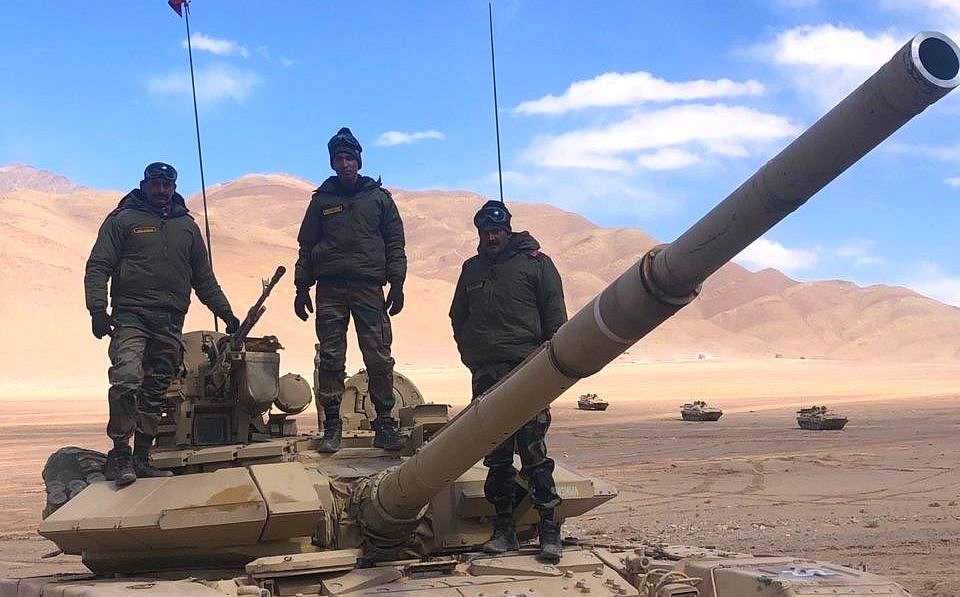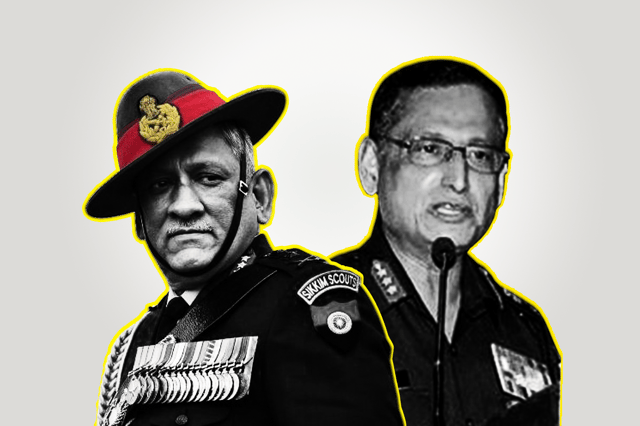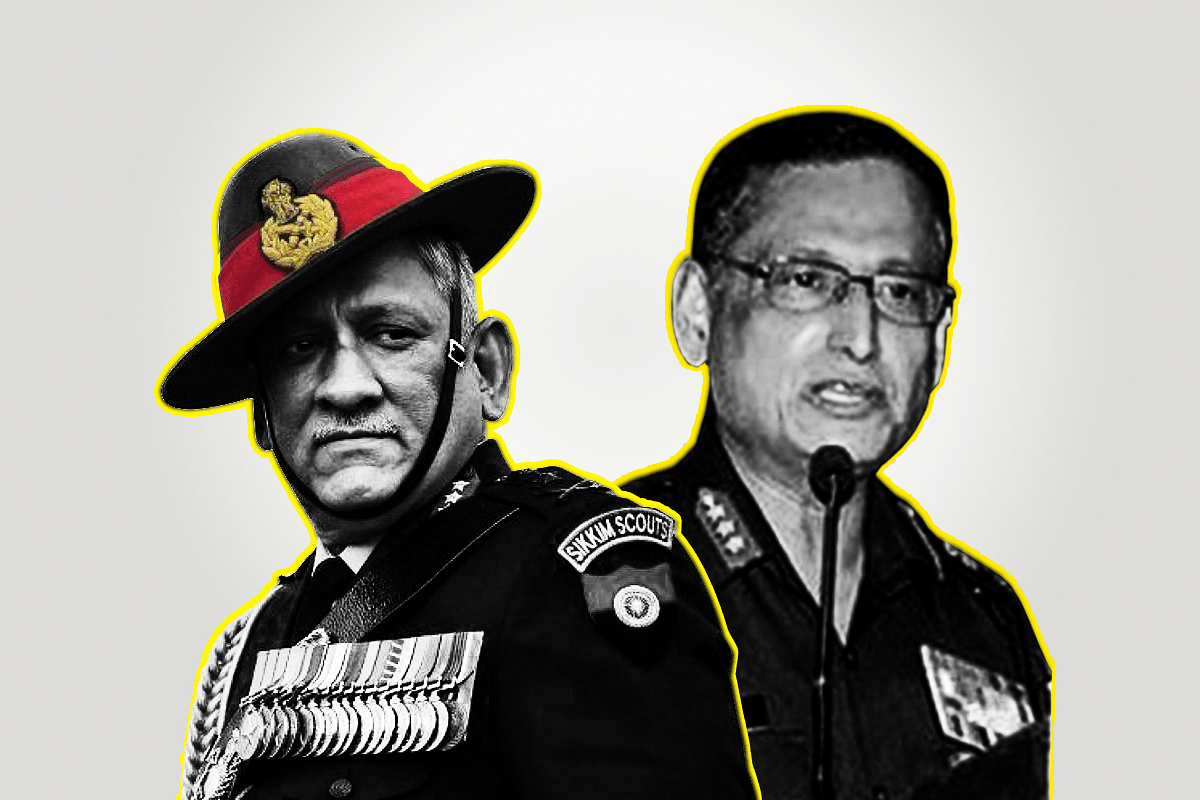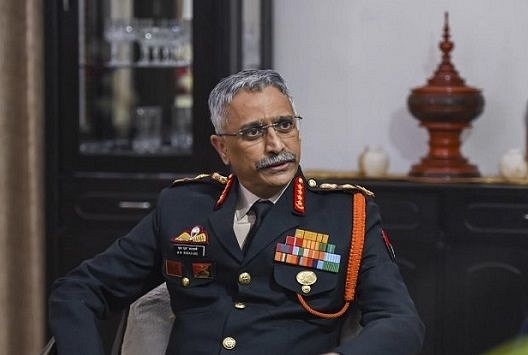Genuine Indigenisation Starting In Arms Procurement; Two Heroes Deserve A Salute For It
by
Bharat Karnad - Aug 10, 2020 03:14 PM
Bipin Rawat and Subrata Saha
Snapshot
- Two officers in particular have played a stellar role in this process. General Bipin Rawat and Lt General Subrata Saha, who retired as Deputy Chief of the Army Staff (Planning and Systems) in April 2017.
Consistent pressure to end arms imports from small select quarters (like this writer) has worked.
Defence Minister Rajnath Singh yesterday morning announced a negative list of military items that cannot be imported.
Each type of goods has been assigned a timeline beyond which imports are banned. This list took some time coming, but is no less welcome for that.
On this list are items that, by and large, are already being produced in the country. This is fascinating because it reveals the range of production capability existing in the country.
Even so, of the 69 items with the deadline of December 2020, 29 pertain to navy, 28 to army, and 12 to air force, and include such capital platforms as combat helicopters, light combat aircraft, missile destroyers, floating docks, and all manner of guns and radars.
Of the 10 items that have December 2021 as embargo date, eight relate to army and two to navy, including conventional submarines (Project 75i).
Four items are listed with December 2022 as deadline, of which three belong to army and one category — ‘E(lectronic) W(arfare) systems” would be relevant to all the three services.
Of the 15 types of equipment with the December 2023 date for full indigenisation, seven each are army and air force related, with “long range land attack cruise missile” that both air force and navy will want in their inventories. But this is only the first step.
Another list is to soon follow, featuring more high-value weapons systems and critical technologies, and the two negative lists together will give a fillip to the indigenous defence industry.
While the Modi government’s intention is good and well meaning, considering pretty severe timelines in the published annexure, how are all these pieces of capital military hardware to be actually produced in mass in-country?
How are the contracts worth Rs 4 lakh crore in the next seven years, the defence minister has promised, to be actualised?
Rajnath Singh hopes the private sector will pick up most of the workload. Larsen & Toubro, with priceless experience in constructing nuclear power submarines and the only private sector firm with the competence and the shipbuilding wherewithal, is a shoo in for the next generation of diesel submarines, for example.
This is an unusually good fit but, for many reasons, it is an exception.
The reality is that the vast realm of defence public sector units (DPSUs), Ordnance factory Board units, and DRDO labs and research centres, is where the physical and manpower resources are concentrated.
But much of this caboodle is a wasteland owing to low labour productivity, indifferent morale, and despicable work ethos.
An arrangement to energise this sector with private sector project leadership is the answer.
The best model to integrate a national resource base and utilise it is the one I proposed in a paper in 1998 for the Technology subcommittee of the first National Security Advisory Board of which I was member [and featured in my 2015 book ‘
Why India is Not a Great Power (Yet)’].
In brief, this business model envisages dividing up all public sector physical assets along with workforces into two nearly equal defence industrial combines to be led by the two best and most versatile manufacturing sets of companies — Tata and L&T.
The government will continue to own the DPSU/Ordnance Board/DRDO physical facilities and will earn a rent and royalty for each item produced in any of them.
Tata and L&T will be free to use their own resources in conjunction with those in the public sector that managerially they control.
These two complexes will compete for every procurement contract from the military with the government funding development to the prototype stage.
In the runoff between prototypes from both combines for any type of weapon system,
et cetera, the item that has less import content by value will be chosen, thereby incentivising indigenous R&D.
This is a viable business model the government should implement. It is specially attractive as it does not involve privatising any DPSUs, DRDO labs,
et cetera — a move sure to generate very vocal political opposition.
Further, accelerated production of the Tejas LCA Mk-1A for the IAF, for instance, will require more than the two HAL production lines and necessitate the DRDO sharing the design and source codes for the Tejas LCA with several interested private companies willing to install their own assembly lines.
There’ll then be economies of scale all round and enough capacity to not only produce sufficient LCAs for the IAF, but also to spawn revenues from exporting this economical 4.5 generation fighter aircraft to a huge market in developing countries, and funds for developing the Advanced Medium Combat Aircraft and its variants on the anvil.
All this is doable. It needs the strong-willed Modi government to realise this self-sustaining business model.
Still, the fact that the government has articulated a negative list suggests it is finally getting through to the military and, importantly, the government that a dependency status in armaments for the country not just stamps India as a second-rate power, but robs it of military options.
It curbs a certain course of action in a crisis, because, initiating hostilities at intense pace would lead to Indian forces quickly grinding to a halt mid-operation because the stocks of ammunition, spares and ancillaries have run out, and there’s no production capacity in the country to meet the surge demand for critical stuff.
Whence the urge on the part of the armed services in a crisis to carefully husband resources and the available war wastage reserve and war stock rather than fight full tilt, when not trying desperately to avoid fighting altogether (as is the case currently in eastern Ladakh).
A surge industrial capacity is the factor that enables more advanced countries with large defence industrial bases to fight long duration wars to a decision.
It is illustrative of the problem the country has always faced, which no Indian government has sought to resolve — that in a military crisis, almost the first thing the defence minister and ministry teams rushing off to foreign supplier countries to make panic purchases of ammunition, spares, and to make up the shortfall in weapons, and platforms, and ending up paying a hefty premium for the goods so acquired.
Rajnath Singh’s recent trip to Moscow to buy an assortment of military supplies, including Su-30MKIs and MiG-29s, underlines the point.
But surge production capacity comes on the coattails of an industry geared to meet the country’s military needs.
If, however, the armed services are stuck in a rut, preferring imported goods and are, not just reluctant to acquire a stake in indigenous efforts by not committing institutionally to such weapons projects and programmes, but actively conspire to make life difficult for Indian manufacturers, then Modi’s
atma nirbhar Bharat-plan is doomed.
The military’s outlook on indigenous armaments has been slow to change, but is now changing because of a few nationalist-minded senior military officers driving the procurement dynamic from within the armed services.
Two officers in particular have played a stellar role in this process. General Bipin Rawat as army chief championed indigenisation in the army — the senior, the largest and most influential service, and now as Chief of Defence Staff, is staying with the arms self-sufficiency mantra.
But the real and substantive transformation of the army milieu was instituted by Lt General Subrata Saha, who retired as Deputy Chief of the Army Staff (Planning and Systems) in April 2017.
It was during his tenure in Army HQ that the groundwork was laid for the involvement of Indian private sector companies in meeting the army’s materiel requirements.
He removed procedural and bureaucratic roadblocks and established protocols and approaches that Indian companies, for a change, found conducive.
Saha’s initiative, in one sense, eventuated in Rajnath’s negative list, and India is finally and belatedly setting out on the road to self-reliance in arms.
This is a heartening development. Three cheers for Generals Saha and Rawat. Their positive roles need to be recognised.
But Saha and Rawat notwithstanding, the deep down antipathy to indigenously produced military equipments is still rife in the military.
The three armed services are differentially tuned to the ‘
atma nirbharta’ drive. The navy is deemed by industry-
wallahs to be the “friendliest” to private sector industry and indigenous goods, perhaps, because until recently, its warship directorate was the only weapons platforms design agency in the Indian military.
The army, thanks to Saha and Rawat, is now ramping up in this direction. The Indian Air Force, in contrast to its sister services, is the laggard, still has its “head in the sky” as an industry leader tellingly put it, and, far from coming down to earth, the IAF brass is on an unwarranted high from the entry of the Rafale, and continues to swear by foreign aircraft.
Given the current thinking of the government, Air HQ better get its head in the right place and give up the ghost of additional Rafales and the like, and invest fully in the Tejas, its variants, and the AMCA, instead.
The army is now on the right side of indigenisation, but even with Saha’s endeavours, a residual bad attitude remains.
Here’s an example of how the army succeeded in frustrating an Indian company from proving that its product was qualitatively better than the foreign item the army procurement officials had set their sights on.
An Indian company had produced an air defence radar that it claimed would more speedily and effectively spot a target with smaller radar cross section (RCS) at a longer range than the foreign favourite the army officers were tilting towards.
Instead of flying its helicopters and aircraft against this radar to test its performance, which was their job, the army officers demanded the company do all this on its own, and otherwise thought up every ruse and put up every hurdle in the book and some to deny this company the opportunity to prove the high-quality radar it had developed at its own cost was better than the imported
maal!
In the early 2000s, the army, even more notoriously, had sidelined an army project headed by a bright army signals officer (Colonel KPM Das), which had within two years, produced a cheap, tech innovation — a handheld device with a fluid screen — SATHI (Situational Awareness to be Handled by Infantry) based on the Bangalore-developed ‘simputer’.
The simputer (or simple computer) project, if the Indian government had pursued with vigour, would have resulted in children in the remotest villages becoming computer literate by now for a relatively small investment by the HR Ministry.
The simputer was combined by the Das team with other off-the-shelf technologies to come up with SATHI.
This device was able to fuse information from various sensors and sources and able literally to see round the corner, enabling infantry jawans — with mobile telephone handling skills — to avoid ambushes and friendly fire incidents.
It was hailed as a revolution and a boon by troops in the field, especially those engaged in counter-insurgency ops.
This project died, not owing to lack of funds, but because not a single senior Lieutenant General rank officer lined up to “take ownership” of it, and to shepherd its development through to operational induction.
Having discarded a successful in-house project that produced such a stellar product, the army may soon be in the market for just such an item.
The foreign vendor, in turn, will likely put together the same technologies the Das-led team had done 15 years back, and sell it to the army at many times the price of SATHI (For those interested in reading more about this case, it is detailed in my book —
Why India is Not a Great Power (Yet), pages 321-323.)
An exasperated Col. Das, upped and retired from service, only to be picked up by Cisco Systems as its Vice President later.
The SATHI episode encapsulates India’s tragedy. And the limits of the government’s good intentions, if the armed services are not fully on board.
Two officers in particular have played a stellar role in this process. General Bipin Rawat and Lt General Subrata Saha, who retired as Deputy Chief of the Army Staff (Planning and Systems) in April 2017.
swarajyamag.com








 en.wikipedia.org
en.wikipedia.org
